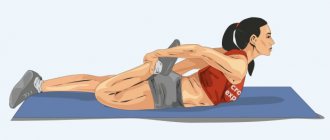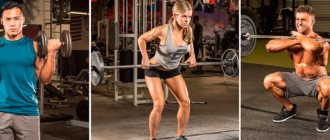What should a real athlete be like? Strong or resilient? Of course, both. Try these explosive strength and endurance workouts and discover what being tough really means for you.
You can't claim to be truly strong if you bypassed developing general endurance and spent all your time building strength or muscle growth. However, if you've been a real nerd, the suggested endurance workouts will appeal to you!
In this article, you'll learn how to develop different types of endurance through intense barbell routines and a variety of cardio exercises.
ENDURANCE - the body's ability to develop sustained effort over a period of time. The level of endurance is determined by the time during which a person can perform a given physical exercise.
In the world of bodybuilding and powerlifting, strength and recovery are heavily emphasized, and endurance is not given the importance it deserves. However, endurance is an important component of good physical fitness, which is important when lifting significant weights.
In general, it will allow the body to recover faster and train longer. You'll also recover faster between sets, meaning you'll have shorter rest times later on.
Many powerlifters and strength athletes believe that working on endurance will have the opposite effect and slow down the recovery process. Often, powerlifters strive to gain or maintain existing weight, and therefore do not include any intense training for speed and endurance, such as martial artists.
Remember that endurance for strength athletes is not work until he starts to choke, endurance primarily helps to be in good shape and speed up recovery.
If you are a strength athlete, be sure to dilute strength training with work on developing aerobic (general) endurance. Start slowly, adding one short cardio session each week.
Endurance is extremely important for staying healthy and maximizing your performance. In powerlifting, moreover, training is associated primarily with a low range of repetitions (up to 5-6), which do not develop overall endurance. But it's not that simple. Let's consider the question in more detail.
What is endurance: general and special?
There are general and special endurance. General endurance is the ability to perform work of moderate intensity for a long time with the global functioning of the muscular system. In another way, it is also called aerobic endurance .
The body's ability to develop sustained effort over a period of time. The level of endurance is determined by the time during which a person can perform a given physical exercise.
A person who can endure long running at a moderate pace for a long time is able to perform other similar work at the same pace (swimming, cycling, etc.). The main components of general endurance are the capabilities of the aerobic energy supply system, functional and biomechanical economization.
General (aerobic) endurance plays a significant role in optimizing life activity, acts as an important component of physical health and, in turn, serves as a prerequisite for the development of special endurance.
Special endurance is endurance in relation to a specific motor activity. Special endurance is classified:
- according to the signs of motor action with the help of which a motor task is solved (for example, jumping endurance);
- according to the signs of motor activity, under the conditions of which the motor task is solved (for example, gaming endurance);
- based on signs of interaction with other physical qualities (abilities) necessary for the successful solution of a motor task (for example, strength endurance, speed endurance, coordination endurance, etc.).
Special endurance depends on the capabilities of the neuromuscular system, the speed of consumption of intramuscular energy sources, the technique of mastering motor action and the level of development of other motor abilities.
To avoid misunderstandings, in this material we will understand Special endurance as Strength endurance .
Different types of endurance are independent or have little dependence on each other. For example, you can have high strength endurance, but insufficient speed or low coordination endurance. Therefore, we recommend placing emphasis in training on comprehensive, balanced and versatile development.
Useful tips
Exercises that help develop endurance have their own differences and characteristics:
- Endurance loves high-quality recuperation, good nutrition and a moderately active lifestyle.
- Complete rest. Endurance is not training for weight loss, where you need to move as much as possible. Between endurance training, you need to give your body proper rest, visit saunas, and get a massage. But a long rest can also provoke a disruption in the recovery process.
- Proper nutrition for full recovery. The diet should be dominated by pure carbohydrates. If you can’t eat more than normal, you need up to 6 g per 1 kg of body weight, then you can use recovery drinks and special gels.
- Alternate between working on strength and endurance. Intensive training includes powerful running, cycling and swimming sessions. Classic training - 30 sec. loads, 1 minute moderate pace.
- Rest between sets should be minimal, and with circuit training there should be no rest.
- The number of repetitions should be at least 12 for a heavy basic program, and at least 15 for a light program.
- It is important to monitor your heart rate during training. You should definitely purchase a heart rate monitor and its needle should not go into the red zone.
- To get maximum benefits, workouts should be done at least 4 times a week.
- Weight is not required, the main thing is the total load and the number of repetitions.
- You can listen to music while exercising. With its help, you can easily keep the pace and improve your mood.
- Include beet juice in your diet. Scientists have proven that it contains large amounts of vitamin C and antioxidants. It helps you get extra carbohydrates and effectively fights fatigue.
The technique of performing exercises that involve endurance training differs from the classical one . You won't be able to build muscle, strength, and endurance at the same time. You should train constantly, even a short break will not be beneficial, all results will be reduced to zero.
Exercises to develop aerobic endurance
Aerobic endurance is determined by the lactate threshold. The higher your lacatate or aerobic threshold, the greater your aerobic endurance. This type of endurance is primarily related to the function of the cardiovascular system and is trained using continuous and interval training. All types of efforts can be divided into three types:
- Short - from 2 to 8 minutes
- Medium - from 8 to 30 minutes
- Long - 30 minutes or more.
When considering and applying the following exercises and complexes to yourself, select those that, working with them in conditions that suit you personally, will help improve the necessary qualities of motor abilities. In general:
- Continuous training helps in improving maximal oxygen uptake (V02max);
- Interval training is necessary to improve the muscular activity of the heart.
Brisk walking, trekking, running or trail running
By trying the exercises in this order, increasing in intensity, you will find your optimal format for developing aerobic endurance. Walking and running can be done both on a treadmill and outdoors. Start with 20-30 minutes once a week, and then add another walk as you progress.
Walking does not put much strain on your joints, and besides, this pleasant time in the fresh air should do you good: it improves your complexion and saturates your lungs with oxygen.
Running up the stairs
Not a suitable park nearby? You can always run 3-4 times to the top floor of your house. Not interesting enough? Take a couple of 1.5 liter bottles with you.
Stair running is an effective cardio exercise option. In one hour of such exercise, almost 1000 kcal are burned, and it is not at all necessary to run this entire hour - you can vary the load or combine running with other exercises or dilute the intervals with a calm walk. Most incline treadmills simulate a similar load.
While jogging up the stairs, many muscle groups work - buttocks, legs, back and abs. Running into a 10-story classic Soviet high-rise building in 1.5-2 minutes and then descending evenly will create exactly the right type of load.
In 20-30 minutes of stable work, those 10-12 intervals, you will strengthen the cardiovascular system, increase the overall endurance of the body, improve joint mobility, strengthen bones and ligaments.
Running uphill and into hills
Alternatively, for those who feel more comfortable on the trail, hill running can be recommended. This type of running is suitable for those who have already acquired some physical shape and is extremely useful for powerlifters: thanks to running, they can increase the load in the gym.
Find a suitable long hill and train harder. Stick to long sprints of 200-300 meters. Depending on the angle of inclination, you should run into it no earlier than 1 minute. Ideally, also up to 2 minutes.
You can also start with short sprints of 30-50 meters. In addition, jogging can also be done on a flat surface. You can also do a sprint every few minutes while walking.
Riding a mountain or road bike
Cycling, like walking or running, is easy on your joints and is another way to exercise outside. You can, of course, work on an exercise bike in the gym, but it quickly gets boring. Follow the same plan as when walking. First, once a week for 20-30 minutes, then add duration or another workout.
In-gym equipment to improve aerobic endurance
In the gym, we recommend using the safest rowing machine and elliptical. To develop long-term aerobic endurance, also work in the second zone for 30-45 minutes according to a selected program.
Exercise "Rowing"
Sit on the rowing machine. Keep your back straight, body slightly tilted forward, knees bent. Straighten your legs until your arms reach the level of your upper abs. Come back, straightening your arms and bending your knees, moving your body forward again.
Elliptical training
Stand on the elliptical, adjust the machine manually, or select a specific program. Adjust the height as necessary. Use the knobs on the machine to change the intensity of your workout.
Characteristics of Key Exercises for Development of Fundamental Motor Abilities
In the situation of choosing the intensity of training and building its structure, we recommend that you be guided by the following logic for developing the necessary qualities and types of load.
| Target quality | Load interval | Work-rest ratio | Intensity | Number of repetitions | Number of episodes |
| Maximum speed | 7-15 s | 1: 10 | Maxi small | 5-8 | 2-5 |
| Anaerobic glycolytic power | 30-50 s | 1: (4-5) | Submaxi small | 4-6 | 2-4 |
| Anaerobic glycolytic endurance | 1-1.5 min | 1:3 | High | 8-12 | 1-3 |
| Aerobic power | 1-2 min | 1: (1-0,5) | Higher average | 5-8 | 1-3 |
| Aerobic endurance | 1-8 min | 1: 0,3 | Average | 4-16 | 1-3 |
| Reduction, oxidation of fats | 20-90 min | — | Low | 1-3 | — |
Let us next consider the possibilities of improving special strength endurance.
Expert opinions
Expert opinion
Ruslan Panov
Coordinator of X-Fit group programs in Russia.
Ask a Question
In these difficult times, it is certainly better to limit yourself to home workouts. I often conduct online classes. But at home it is better to take some precautions: practice where nothing interferes, distancing yourself from sharp corners and moving objects. All you need is 2*3 meters.
Expert opinion
Ksenia Molostova
Personal movement trainer
Ask a Question
Beginners should focus on training at home up to three times a week. You also need to understand why they are needed. If you have set a goal to build your body and maintain health, then increase the load and frequency of training.
Expert opinion
Diana Akhmadishina
Adidas Runners Captain and Senior Coach
Ask a Question
The main thing you need to understand when conducting training complexes at home is to act according to a personally drawn up plan. This will help you stay in shape and distribute the load correctly.
Strength endurance exercises
Strength endurance is the ability to implement large impulses of force during the required period of load with an insignificant difference between the maximum possible and the realized impulse of force. Or, in other words, it is the ability to withstand fatigue when working at almost maximum power for up to 3-4 minutes, performed primarily due to anaerobic-glycolytic energy supply.
From this definition it is clear that strength endurance manifests itself only in the case of heavy weights and significant muscle contractions. If the weights are small, and the muscles contract far from full power, then it is more correct to talk about general aerobic endurance. The most interesting workouts, for example, in CrossFit complexes, are based on a competent combination of both types of activity.
Strength endurance training depends on the load characteristic of a particular sport and should form a level of special load “above average” with a number of repetitions close to the maximum.
Sled pull
Recently, such deadlifts have become very popular in the world of powerlifting and crossfit. They can be performed on training or rest days. However, you need to start carefully so that they do not interfere with your strength training. You don't have to buy an expensive sled. And it’s enough just to tie a rope to the working weight or use support levers.
Technique . Find a suitable area and wrap the rope around your waist. You have a weight that you will pull on yourself. Start at a slow pace, 1-2 times a week for 10 minutes. If this does not affect your work in the gym, then you can increase the weight.
You can work on strength endurance using almost any strength exercise. To determine the training structure, you can use the following guidelines based on RM (Repetition Maximum) values:
| Goal of training | Strength endurance | Muscle mass | Maximum strength | Fast Power |
| Intensity/number of repetitions | 15-20 RM (or more) | 8-15RM | 3-8RM | 1-3RM |
| Number of approaches | 1-3 | 4-6 | 3-5 | 3-5 |
| Intervals between series/exercises | 30-60 s | 1-2 min | 3-5 min | 5-8 min |
| Pace | 1010 | 2120 | 1110 | "Explosive" |
| Training frequency (number of days per week) | (1-) 2-3 | 3-5 | 3-5 | 4-6 |
You can add more complex barbell complexes if you are already sufficiently prepared and confident in the technique of each individual exercise.
Complex with barbell “Bear”
The complex involves using light weights and performing a series of exercises without rest, without lowering the bar. One of the popular complexes in CrossFit is known as “Bear”.
The bar is loaded with relatively light weight. You start by placing a barbell on your shoulders and do deep squats with the barbell on your chest. When lifting up, the bar moves behind the head. Next, you place the bar on your back and perform deep barbell squats. Again, when lifting, the bar should be behind your head. Finally, place the barbell back on the floor and start over. You did one rep, but you need to do 6 reps with a light weight. This challenging set of exercises will make you sweat.
Efficient scheme
- do a warm-up for 5 minutes;
- perform jumping ropes, alternating legs (20 times on each);
- jump 20 times without a rope, with your feet together;
- We walk in place for 1 minute to rest and restore our breathing;
- squat 30 times;
- We swing our legs for a minute, restore strength;
- pumping up the abs (40 reps);
- kick kicks (2 sets of 15 times);
- perform pull-ups (2 sets with the maximum number of repetitions);
- run for 20 minutes on a treadmill or in a stadium;
- Raise your arms up and inhale, bend forward and twist in half as you exhale.
Complex with barbell Bear
Circular - 5 circles
Power clean
- 1 set of 7 reps
- Body part: Hamstrings Equipment: Barbell
Front squats with barbell
- 1 set of 7 reps
- Body part: Quadriceps Equipment: Barbell
Press press
- 1 set of 7 reps
- Body part: Shoulders Equipment: Barbell
Quick squats with a barbell
- 1 set of 7 reps
- Body part: Quadriceps Equipment: Barbell
Press press
- 1 set of 7 reps
- Body part: Shoulders Equipment: Barbell
Add to Calendar * Add to My Workouts * Print Workout
* — The service is in beta testing
There are many options for endurance training and strength development. Remember that you need to start small, gradually adding loads. As soon as there is progress in endurance, it will immediately be reflected in the gym. The workouts will seem easy, and you will cope with them faster.
And an additional version of strength training from CrossFit.
Physical endurance exercises at home
The choice among exercises for developing endurance is large, but each of the proposed exercises is basic, which can be performed at any time and anywhere if you have free time.
Let's look at the best of them.
Run
Running allows you to keep your entire body in good shape and also improves your overall health.
- It is very important to maintain an acceptable speed for you while running - this will allow you not to exhaust your body with physical activity, and constantly maintaining it at the same level will make it possible to run more and get the maximum effect.
- It is important to be systematic when running. If you run in the morning, don’t miss a single day. Otherwise, the body will begin to “forget” the amount of load that you gave it previously, and after trying to get back into the process, it may show a lower result.
- In addition to daily jogging, the process of increasing the load is no less important: each time try to run more than before, increase the pace and after increasing it, try not to reduce it.
- “Ragged” running is also popular in the process of developing endurance, but this method should be used no more than 3 times a week, and change the speed about 8 times in one session. It is necessary to run at maximum speed for 30 seconds, and then switch to slow walking for no more than 5 seconds.
Video: Recommendations for running technique to increase efficiency
Jump rope
Jumping rope works effectively as a means to relieve muscle tension. It also does an excellent job of increasing the level of endurance of the human body.
Before you start analyzing the technique of jumping rope, you need to figure out which jump rope is right for you in accordance with your height and watch a video with tips on how to perform the exercise.
Table: Correspondence of the length of the jump rope to a person’s height.
| Height, cm | Rope length, m |
| up to 150 inclusive | 1,8 |
| 151–165 | 2,5 |
| 165–175 | 2,8 |
| 176–185 | 3 |
| from 186 | 3,5–3,8 |
Also, without measuring your height, you can simply fold the rope in half and bring the resulting length of equipment to you - the rope should not be higher than your shoulder. If the rope is too long and there is no other rope, you can wrap part of the rope around your wrists and feel free to start jumping.
- It is very important to ensure that the entire foot leaves the surface when jumping.
- Beginners should jump for at least 15 minutes per approach. It is advisable to do at least 3 approaches per day.
- To eliminate monotony while jumping rope, you can jump over it with each leg in turn, cross them while jumping, and so on.
Jumping rope strengthens the cardiovascular system and helps fight excess weight if this exercise is included in your daily workout routine.
Video: Analysis of jumping rope technique
Pistol squats
A fairly complex version of squats, for mastering which a beginner may need a number of leading exercises, such as squats on one leg against a wall or with a partner.
Technique:
- Starting position: stand straight, the distance between your feet is equal to the width of your shoulders, your head is straight. Raise your right leg and transfer your body weight to the left. Finding balance. You can stretch your arms forward or spread them to the sides - their position depends on how comfortable it is for you.
- Gradually we begin to squat on the left leg, while stretching the right leg forward. During a squat, the pelvis should move back, but under no circumstances should it tuck forward - the level of development of the flexibility of your hip joint plays a huge role here. Of course, we make sure that the back remains straight throughout the entire approach. The squat is carried out until the biceps of the thigh presses against the calf muscle. During the final squat, the leg extended forward should be parallel to the horizontal surface, the knee of the bent leg may slightly extend beyond the line of the toe.
- We return to the starting position by pushing off with the heel of the left foot. During the ascent, we also lower our right leg.
A - starting position, B - squat.
This exercise should be repeated as many times per set as you can. But there should be several approaches themselves, at least 2–3. If you manage to do 20 or more repetitions in one approach, this suggests that you should look for a more complicated exercise in terms of physical stress on the muscles or perform pistol squats with additional weight.
Video: Useful tips on the pistol squat technique
Pull-ups on the horizontal bar
To develop endurance during pull-ups on the horizontal bar, you need to do the maximum number of repetitions and practice daily. The most effective program includes at least 5 sets with the highest number of repetitions.
Before you start doing pull-ups, you should choose a horizontal bar that is suitable for your height - while hanging, you should not touch the support with your feet.
- We grab the horizontal bar with a direct grip, palms at a distance wider than your shoulders, do a hang, cross your legs - this will be the starting position.
- As you exhale, begin to pull your torso toward the bar until your chest touches it.
- We stay in this position for a few seconds.
- As you inhale, slowly lower your torso down. The legs are still crossed.
- We perform the greatest number of repetitions.
On the left is the starting position, on the right is the final position, pull-up.
What are the advantages of pull-ups over other endurance exercises? Firstly, the muscles of the back and upper shoulder girdle develop, secondly, grip strength is strengthened, thirdly, subject to a healthy lifestyle and proper nutrition, there is a chance of losing excess weight, since when doing pull-ups on the bar, energy consumption increases significantly, and, fourthly, it is assumed that there is grip variability, which allows you to shift the degree of load on certain muscle groups.
Video: Useful tips for pull-ups on the bar
Push ups
During push-ups, the pectoral muscles, triceps and deltoids of the shoulder muscles actively develop. The core stabilizing muscles work as “helpers”.
- Starting position - we take a lying position, the position of the palms is slightly wider than shoulder width, the body is tense, the abdominal muscles are tense, the legs are on the toes, slightly apart from each other.
- While inhaling, we proceed directly to push-ups, lowering the body by bending the arms at the elbows until a few centimeters remain between the chest and the horizontal surface.
- As you exhale, we return to the starting position.
- We perform the required number of repetitions until the completion of the approach.
When performing push-ups, it is very important to maintain a tense state of the muscles and feel their work throughout the entire approach.
When performing push-ups as one of the exercises in a set of general endurance training, like pull-ups on a bar, you need to perform the greatest number of repetitions and approaches.
Jumping in place with high knees
Such jumping is considered more effective than running in terms of burning calories.
- Starting position - stand straight, the distance between the feet is equal to the width of the shoulders, the arms are along the body.
- We make a jump, during which we raise our knees high and try to touch our knees with our palms, or simply stretch our arms forward.
- We return to the starting position.
- We do as many repetitions as possible until the set is completed.
This exercise, like the previous two, does not have a specific number of repetitions and approaches - we jump as much as we can, but the break between jumps should be minimal.
A is the starting position. B - jump.
Plank
The plank is a well-known exercise that perfectly tightens the abdominal muscles. It is worth noting that the plank does not pump up the muscles, but only strengthens and shapes them, and accordingly, it has every right to be on the list of endurance exercises.
In the plank, in addition to the abdominal muscles, the work also includes the anterior muscles of the arms and legs, shoulders and rectus dorsi.
Starting position - lying down with support on your toes and elbows, stretch your body, strain your abdominal muscles, “twist” your tailbone and strain your buttocks. It is necessary to maintain a straight, tense body throughout the exercise. Otherwise, the bar will not have the desired effect. Try to hold yourself in this position for at least 30 seconds. The maximum is again not limited - it all depends on the physical fitness of your body.
Burpee
Burpee is a compound exercise because it includes simple exercises that together represent a small complex aimed at strengthening several muscle groups at once - quadriceps, hamstrings, buttocks, calves, pectoralis major muscles, triceps, deltoids and abs. This complex is formed by the following exercises: push-ups, squats, jumping.
In its classic form, a set of exercises called burpees looks like this:
- Bend forward so that your palms touch the floor.
- Next comes a reclining position and push-ups.
- This is followed by a return to the original slope using a jump.
- Then there is a jump again, but this time upward - jumping out.
- After this, the cycle begins again, with an inclination.
Try to work at a high tempo for as many reps as possible.
Systematic implementation of burpees leads to the development of almost all muscles of our body.
Burpee perfectly trains the respiratory and cardiovascular systems and speeds up the metabolic process in the body. It is an excellent exercise as a daily morning exercise at home.
Video: Detailed analysis of burpee technique and the most common mistakes
Strength endurance. Running and barbell
Circuit – 3 laps
Treadmill workout
- 1 lap 400 meters
- Body part: Quadriceps Equipment: Exercise
Clean and jerk
- 1 set of 10 reps
- Body part: Shoulders Equipment: Barbell
Add to Calendar * Add to My Workouts * Print Workout
* — The service is in beta testing
And street workouts in styleworkout.
Endurance training on horizontal bars
Circuit – 3 laps
Treadmill workout
- 1 lap 400 meters
- Body part: Quadriceps Equipment: Exercise
Pull-ups
- 1 set of 8, 6, 4 reps
- Body Part: Lat Equipment: Bodyweight
Triceps dips
- 1 set of 16, 12, 8 reps
- Body Part: Triceps Equipment: Other
Reverse grip pull-ups
- 1 set of 8, 6, 4 reps
- Body Part: Lat Equipment: Bodyweight
Platform push-ups
- 1 set of 16, 12, 8 reps
- Body part: Chest Equipment: Body weight
Add to Calendar * Add to My Workouts * Print Workout
* — The service is in beta testing
In the same way, women can tailor their CrossFit training to develop aerobic, strength endurance, or a combination of both, and significantly improve their training.
Day four
Increases strength.
Power cycle
Perform all exercises in 3 sets of 12, 10 and 8 repetitions
- Lunges with dumbbells in hands
- Leg bending in the simulator
- Push-ups
- Incline Bench Press
- Pull-up on the bar
- Sitting cravings to the stomach
- Dips
Cycle of exercises with a ball
Try to perform all these exercises with sharp movements. Each requires two sets of 10 repetitions. If desired, they can be replaced by throwing the ball from behind the head or performing a movement on a block simulator that imitates cutting down a tree at the root. Start with a 3kg ball.
1. Throw from under your feet
Place your feet slightly wider than shoulder-width apart. Take the ball in your hands, swing it between your legs and, bending your knees, throw it as far in front of you as possible with your straight arms.
2. Overhead throw
Place your feet on the floor, bend your knees slightly, lift the ball behind your head, like a throw-in in football, and then, using the muscles of your legs, stomach and shoulder girdle, throw it forcefully at the wall in front of you.
3. Side impact
Kneel down, grab the ball with both hands and lift it high above your shoulder. Tightening your torso muscles, forcefully lower the ball to the floor so that it ends up at the opposite knee. This exercise strengthens the oblique abdominal muscles.
4. Diagonal throw
With your knees slightly bent, hold the ball in front of you at waist level. Rotate your hips and swing your arms to one side, then quickly throw the ball as far away from you as possible. Repeat on the other side.
Building workouts to develop endurance
When starting work on developing endurance, it is necessary to adhere to a certain sequence of training.
- At the initial stage, it is necessary to focus on developing aerobic capabilities, improving the functions of the cardiovascular and respiratory systems, strengthening the musculoskeletal system, i.e. development of general endurance.
- At the second stage, the volume of loads should be increased in a mixed aerobic-anaerobic mode.
- At the third stage, increase the volume of loads through the use of more intense exercises performed by the methods of interval and repeated work in mixed aerobic-anaerobic and anaerobic modes, and selective impact on individual components of special endurance.
What kind of endurance is there?
It is not difficult to remember the division of this quality.
There are two types of stamina: general and special.
- General endurance - the ability to walk, ride a bike, swim, run for a long time. Not fast, not on difficult terrain, but just move - with a low heart rate and not particularly tired.
- But special endurance is divided into: Difficult coordination - you can do exercises that require good coordination for a long time, for example, dancing or playing football;
- High-speed - you can walk, run or pedal quickly for a long time;
- Speed-strength - you can run a series of sprints or jump rope for a long time without losing momentum;
- Strength - you can do exercises with significant weights, repeating cycles at minimal intervals.
“It should be noted that sometimes the division is very arbitrary,” says Dmitry Lapkin, fitness trainer, host of the online fitness project Fit & Well . - For example, if you do push-ups at a fast pace, this can be classified as speed-strength endurance. If you do push-ups for a long time, efficiently, but it’s too hard for you to do it at a fast pace, this is already strength endurance.”
Endurance Training Supplements for Men
Olimp Sport Nutrition | Beta Alanine Xplode?
- Contains a matrix of additional ingredients that allow you to quickly and without loss overcome the gastric barrier and getting directly into the muscles, it does not turn into a by-product in the human body and does not overload the liver.
- Category: Amino Acid Complex More about the category
Recommendations for use: one serving before training. Recommendations for preparation: depending on body weight: up to 70 kg - dissolve 3 g in 80 ml of cold water. 70-85kg - dissolve 6 g in 160 ml of cold water. Over 85 kg - dissolve 9 g in 240 ml of cold water.
The advantage of Olimp Sport Nutrition “Beta Alanine Xplode” is that it is presented in powder form. This way you can choose the correct portion size depending on your body weight.
Olimp Sport Nutrition | Knockout 2.0?
- New formula for an excellent pre-workout complex. Benefits: 2g beta-alanine and 1g el-arginine for impact training!
- Category: Pre-workout supplements
Take one serving (6.1 g of powder or ½ scoop) 30 minutes before training mixed with 250 ml of water
Ingredients: L-citrulline, beta-alanine, citric acid, L-arginine hydrochloride, taurine, L-tyrosine, silicon dioxide, flavors, caffeine, guarana seeds, barley extract, acesulfame K, sucralose, sodium cyclamate, cayenne pepper seed extract , black pepper seed extract, ramus serrata leaf extract, carotene, carmine, riboflavin, E150c, E150d, E133, indigo, chlorophyll and chlorophyllin, curcumin, anthocyanin, paprika extract, betanin, plant carbon.
VPLAB Nutrition | Ultra Men's Sport Multivitamin Formula ?
- A high-tech complex of natural vitamins and minerals was developed taking into account the characteristics of male physiology for men leading an active lifestyle.
- Category: Vitamins for men More about the category
1 capsule 2 times a day
Taking the VPLaboratory Ultra Men's Sport Multivitamin Formula vitamin and mineral complex will help eliminate nutrient deficiency in the body, which causes premature fatigue, insufficient recovery and decreased body tone.
BioTech | Creatine Monohydrate?
- Prepared using pure creatine monohydrate in powder form.
- Category: Creatine More about the category
5g (1 teaspoon) in the morning on an empty stomach, before and after training for 4 weeks
Its neutral-tasting powder form makes it easy to mix with other supplements such as weight gainers or protein shakes. 100% creatine monohydrate is used by athletes to increase muscle strength and endurance and also to catalyze an increase in cell volume and increase muscle mass. How does creatine monohydrate work? Many studies have shown that creatine increases muscle strength and mass. Since then, creatine monohydrate has become the most popular and most effective supplement in the world of strength athletes.
USPLabs | Modern BCAA+ ?
- 8:1:1 Formula. USPlabs Modern BCAA is an amino acid ratio of Leucine-Isoleucine-Valine 8-1-1
- Category: BCAA More about the category
mix 2 scoops per 350-400 ml of water or other drink and take 30 minutes before and immediately after training
Why is there so much leucine? The reason is that leucine plays a key role in increasing the concentration of mTOR and, therefore, the concentration of this amino acid should be at the highest possible level.
Sports nutrition recommendations are indicative only. Before purchasing, we recommend that you consult with a specialist in the store.
The contradiction between strength and endurance
How to correctly combine both types of physical training that seem to be absolutely opposite in technique? After all, with strength training, an important stage in the work is complete rest between sets of exercises and the workouts themselves (quality rest is responsible for the effectiveness of the training and the final desired result in gaining muscle mass).
When training for endurance, the main criterion will be the increase in aerobic capacity of the muscles, that is, an increase in the time during which the same exercise is performed at a fixed intensity (at the same time, endurance, due to the increase in the strength of the cardiovascular system, increases significantly, but in terms of muscle volume this is does not have any effect).
Numerous studies by scientists from the NSCA indicate that it is impossible to simultaneously improve performance in these two areas: increasing endurance and strength, and in some cases this even harms the body and reduces quality strength indicators.
To support this, they give a number of reasons why, in their opinion, combined strength and endurance training does not work or does not work effectively:
- Lack of proper rest will lead to overtraining and ultimately to stagnation of muscle growth;
- It is an unbearable difficulty for the body to adapt to two training regimes at once;
- Extreme fatigue of the body and subsequent complete exhaustion, especially when conducting two types of training on the same day;
- Imbalance between the catabolic and anabolic systems in the body during parallel training.
However, in practice, the opposite is confirmed. Particularly positive results from mixed training are visible when introducing strength exercises into an endurance program in sports such as sprinting, cycling and others, that is, where you need to apply more force to the “final push” and delay the onset of fatigue.
Consequence: if everything is done correctly and in a balanced manner, then parallel training for strength and endurance still gives its positive results and the opportunity to get the desired physical shape with the greatest increase in the sports performance coefficient.









